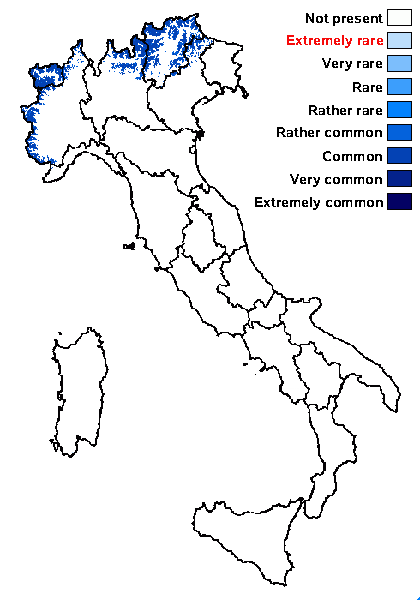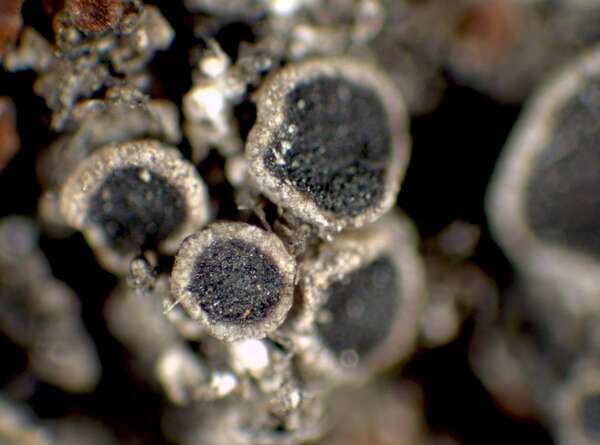Rinodina turfacea (Wahlenb.) Körb.
Syst. Lich. Germ.: 123, 1855. Basionym: Lichen turfaceus Wahlenb. - Fl. Lappon.: 408, 1812.
Synonyms: Berengeria turfacea (Wahlenb.) Trevis.; Psora turfacea (Wahlenb.) Hepp; Rinodina orbata (Ach.) Vain.; Rinodina turfacea var. orbata (Ach.) Jatta
Distribution: N - Ven (Nascimbene & al. 2021), TAA (Nascimbene & al. 2022), Lomb, Piem (Isocrono & al. 2004), VA (Piervittori & Isocrono 1999, Valcuvia 2000), Lig.
Description: Thallus crustose, episubstratic, thin to thick, rugose to verrucose, pale brown, grey-brown or whitish grey, without a distinct prothallus. Apothecia lecanorine, usually abundant and often crowded, 0.5-1.7(-2) mm across, constricted at base, with a black to brownish black, concave to flat disc, and a thin, entire to crenulate or flexuose thalline margin. Thalline exciple 40-70(-100) µm wide laterally, expanding to up 150 µm in lower part, the cortex 5‑10 µm thick, sometimes with an epinecral layer, I+ pale blue, the medulla with crystals; proper exciple colourless to pale brown, 5‑10 µm wide laterally, expanding to 20‑50 µm in upper part; epithecium brownish, K-; hymenium colourless, not inspersed with oil droplets, (90-)110-150(-170) μm high, I+ blue; paraphyses 1.5-2(-2.5) μm thick at mid-level, the apical cells to 3-5.5 μm wide; hypothecium colourless, (15-)20-50 µm high. Asci 8-spored, broadly clavate, the K/I+ blue tholus penetrated by a faintly amyloid apical cushion with parallel or diverging flanks, the wall K/I-, surrounded by a K/I+ blue outer layer, Lecanora-type. Ascospores 1-septate, dark olive to olive-brown, ellipsoid, (20-)25-30(-35) x 9-15 μm, Physcia-type, with a well developed torus and an ontogeny of type A (apical wall thickening after septum formation). Photobiont chlorococcoid. Spot tests: K-, C-, KC-, P-, the medulla UV+ blue-white. Chemistry: sphaerophorin and variable amounts of variolaric acid.Note: an arctic-alpine, circumpolar lichen found on soil rich in humus and plant remains in tundra-like habitats.
Growth form: Crustose
Substrata: soil, terricolous mosses, and plant debris
Photobiont: green algae other than Trentepohlia
Reproductive strategy: mainly sexual
Commonnes-rarity: (info)
Alpine belt: common
Subalpine belt: rather common
Oromediterranean belt: absent
Montane belt: absent
Submediterranean belt: absent
Padanian area: absent
Humid submediterranean belt: absent
Humid mediterranean belt: absent
Dry mediterranean belt: absent

Predictive model
Herbarium samples
Growth form: Crustose
Substrata: soil, terricolous mosses, and plant debris
Photobiont: green algae other than Trentepohlia
Reproductive strategy: mainly sexual
Commonnes-rarity: (info)
Alpine belt: common
Subalpine belt: rather common
Oromediterranean belt: absent
Montane belt: absent
Submediterranean belt: absent
Padanian area: absent
Humid submediterranean belt: absent
Humid mediterranean belt: absent
Dry mediterranean belt: absent

Predictive model
| Herbarium samples |
 INDEX FUNGORUM
INDEX FUNGORUM
 GBIF
GBIF
 DOLICHENS
DOLICHENS




